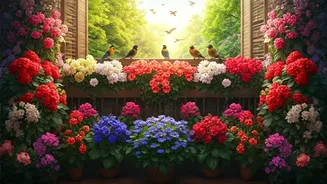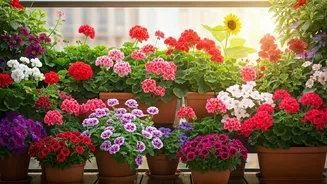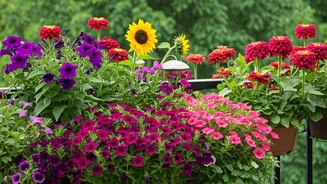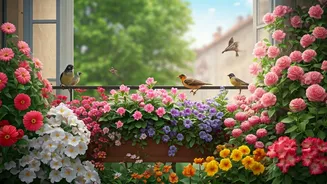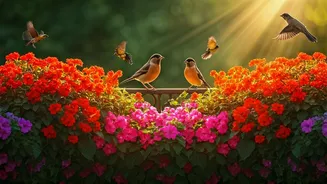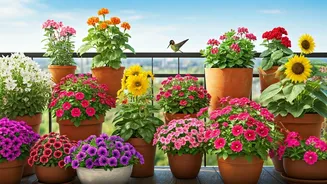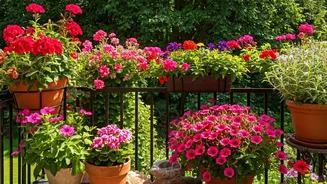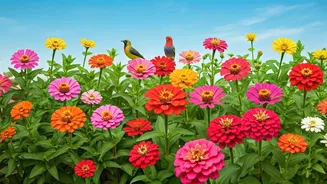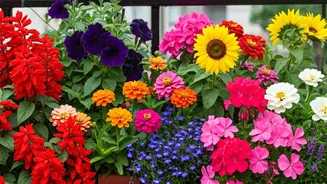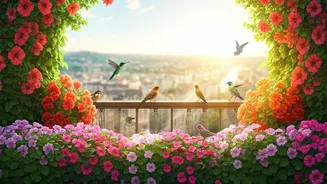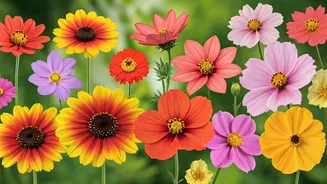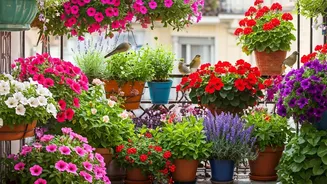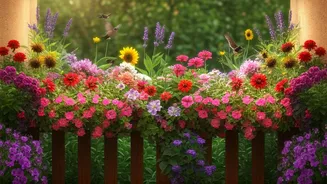Bird-Friendly Blooms
Selecting the right flowers is key to attracting birds to your balcony. Consider the birds' needs when picking blooms. Focus on plants that provide nectar,
seeds, or attract insects—all crucial food sources. Choose diverse plants for varied bird species. Think about the local environment and its birds. Prioritize native plants that naturally suit the local ecosystem. Native plants support regional biodiversity, providing food and shelter that familiar bird species rely on. Ensure the flowers are non-toxic to birds. Steer clear of plants treated with harmful chemicals. By thoughtfully choosing and caring for your flowers, your balcony will soon be filled with the joyous presence of chirping birds.
Petunias' Vibrant Appeal
Petunias, available in many colors, are great for balconies. Their bright, trumpet-shaped flowers appeal to birds that enjoy nectar. Planting petunias in hanging baskets or containers can be done for a cascade of color. Regularly water and fertilize petunias. This helps them stay healthy and continuously bloom, providing a steady nectar source. Petunias are relatively easy to take care of, making them a good option for beginners. When choosing petunias, consider different varieties. Some offer double blooms and varied color patterns, adding visual appeal to your balcony. They offer a simple yet effective way to invite birds.
Marigolds: Sunny Charms
Marigolds, known for their bright hues, are also effective. These cheerful flowers are easy to grow and attract insects. Insects are a vital food source for many birds. Marigolds emit a strong scent. This can deter certain pests, offering a natural pest control. Marigolds come in different types, each with its unique characteristics. Dwarf marigolds are excellent for smaller spaces, while taller varieties offer more foliage. Plant marigolds in well-drained soil and plenty of sunlight. Regular deadheading helps to encourage more blooms and attracts more birds. Their vibrant colors and insect-attracting abilities make marigolds a beneficial addition.
Zinnias: Butterfly Magnets
Zinnias, with their diverse shapes and colors, are great for drawing birds. They are appealing to butterflies and other insects, which in turn attract birds. Zinnias' bright, open blooms provide easy access to nectar and pollen. Planting zinnias is simple and effective. They thrive in sunny spots with well-draining soil. Zinnias are annuals. They provide a continuous display of color. Different types of zinnias vary in size, so consider space when choosing. To make the most of zinnias, select a range of colors and heights. This brings visual variety and increases the chances of attracting a wider array of bird species to your balcony.
Pansies: Cool-Season Appeal
Pansies are perfect for balconies with cooler climates. Their sweet-smelling flowers bloom in spring and fall. These flowers offer nectar to attract birds. Pansies thrive in partial shade and cooler temperatures. This makes them ideal for shaded balcony areas. Pansies are available in numerous colors. They bring a splash of color to your outdoor space. Ensure proper watering and soil drainage to keep pansies healthy. Regular deadheading of faded blooms encourages more flower production. Pansies are a low-maintenance option for creating a bird-friendly balcony during milder seasons. Their resilience and charm make them a favorite choice.
Sunflowers: Towering Delights
Sunflowers make an impactful addition to your balcony garden. These vibrant flowers attract a variety of birds. Birds enjoy the seeds. Sunflowers require ample sunlight and space. Dwarf sunflower varieties can be grown in containers. This makes them a great option for smaller balconies. Sunflowers provide both beauty and sustenance for birds. Consider different varieties of sunflowers. Some offer edible seeds for humans as well. Sunflowers require regular watering, and good soil drainage. Once the flowers fade, leave the seed heads to dry, so birds can enjoy them. Their height and charm create a welcoming environment for chirping birds.
Nasturtiums: Edible Bounty
Nasturtiums are a vibrant, versatile option for a balcony garden. They have edible flowers and leaves. Their bright orange and red blossoms lure birds. The plant is easy to grow, thriving in sunny or partially shaded spots. Nasturtiums can be planted in pots and hanging baskets. They add both beauty and function to a balcony. Nasturtiums require moderate watering and well-draining soil. They are low-maintenance and can brighten any space. Their edible qualities make them a unique and useful addition to a balcony. Using these plants is a straightforward, attractive way to attract birds.
Lantana: Butterfly Magnet
Lantana is known for its ability to attract butterflies and hummingbirds. These colorful, clustered flowers are a great addition. They thrive in warm climates and full sunlight. Lantana can be grown in pots and hanging baskets. It blooms throughout the year. The plant requires regular watering, especially during hot weather. Lantana comes in various colors, adding visual interest. Pruning helps to maintain its shape and encourage more blooms. Lantana offers a combination of beauty and functionality. These plants turn your balcony into a lively area, drawing a range of bird species. They add to the vibrancy of your balcony.
Salvia: Hummingbird Favorites
Salvia flowers are popular with hummingbirds. Their tubular shape makes them ideal for hummingbirds to feed. Salvia varieties come in many colors, from red to purple. They thrive in sunny locations and well-drained soil. Regular watering and deadheading promote blooming. Salvia's flowers offer nectar to draw hummingbirds and other birds. They can be planted in containers or directly in the ground. Salvia is relatively low-maintenance, requiring only basic care. Choosing different salvia species can create a diverse and visually appealing space. Salvia's ability to draw hummingbirds enhances the liveliness of any balcony.
Lavender: Aromatic Attraction
Lavender's aromatic flowers have a unique attraction for birds. Its sweet scent also helps repel pests. Lavender thrives in full sun and well-draining soil. It is a drought-tolerant plant. This makes it a great choice for balconies. Regular pruning helps to encourage blooming and maintain the plant's shape. Lavender can be grown in pots or containers. It adds a touch of elegance and fragrance to any balcony. While not directly offering food, the presence of lavender can make the balcony more attractive to birds. Its easy-care nature makes lavender a good choice. Its beautiful blooms create a welcoming environment.
